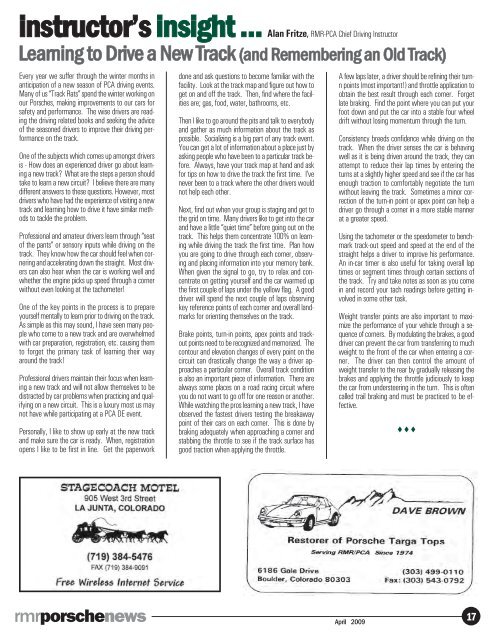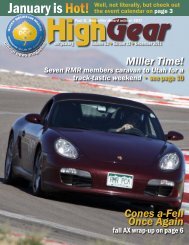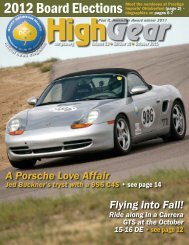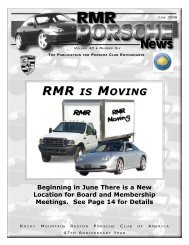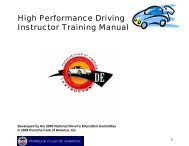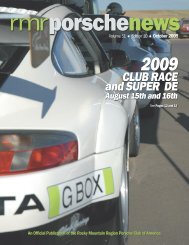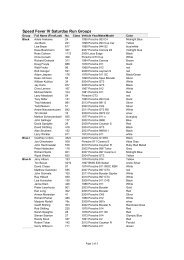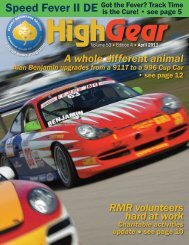Rmr - Rocky Mountain Region Porsche Club - Porsche Club of ...
Rmr - Rocky Mountain Region Porsche Club - Porsche Club of ...
Rmr - Rocky Mountain Region Porsche Club - Porsche Club of ...
Create successful ePaper yourself
Turn your PDF publications into a flip-book with our unique Google optimized e-Paper software.
instructor’s insight ...<br />
Learning to Drive a New Track (and Remembering an Old Track)<br />
Every year we suffer through the winter months in<br />
anticipation <strong>of</strong> a new season <strong>of</strong> PCA driving events.<br />
Many <strong>of</strong> us “Track Rats” spend the winter working on<br />
our <strong>Porsche</strong>s, making improvements to our cars for<br />
safety and performance. The wise drivers are reading<br />
the driving related books and seeking the advice<br />
<strong>of</strong> the seasoned drivers to improve their driving performance<br />
on the track.<br />
One <strong>of</strong> the subjects which comes up amongst drivers<br />
is - How does an experienced driver go about learning<br />
a new track? What are the steps a person should<br />
take to learn a new circuit? I believe there are many<br />
different answers to these questions. However, most<br />
drivers who have had the experience <strong>of</strong> visiting a new<br />
track and learning how to drive it have similar methods<br />
to tackle the problem.<br />
Pr<strong>of</strong>essional and amateur drivers learn through “seat<br />
<strong>of</strong> the pants” or sensory inputs while driving on the<br />
track. They know how the car should feel when cornering<br />
and accelerating down the straight. Most drivers<br />
can also hear when the car is working well and<br />
whether the engine picks up speed through a corner<br />
without even looking at the tachometer!<br />
One <strong>of</strong> the key points in the process is to prepare<br />
yourself mentally to learn prior to driving on the track.<br />
As simple as this may sound, I have seen many people<br />
who come to a new track and are overwhelmed<br />
with car preparation, registration, etc. causing them<br />
to forget the primary task <strong>of</strong> learning their way<br />
around the track!<br />
Pr<strong>of</strong>essional drivers maintain their focus when learning<br />
a new track and will not allow themselves to be<br />
distracted by car problems when practicing and qualifying<br />
on a new circuit. This is a luxury most us may<br />
not have while participating at a PCA DE event.<br />
Personally, I like to show up early at the new track<br />
and make sure the car is ready. When, registration<br />
opens I like to be first in line. Get the paperwork<br />
rmrporschenews<br />
done and ask questions to become familiar with the<br />
facility. Look at the track map and figure out how to<br />
get on and <strong>of</strong>f the track. Then, find where the facilities<br />
are; gas, food, water, bathrooms, etc.<br />
Then I like to go around the pits and talk to everybody<br />
and gather as much information about the track as<br />
possible. Socializing is a big part <strong>of</strong> any track event.<br />
You can get a lot <strong>of</strong> information about a place just by<br />
asking people who have been to a particular track before.<br />
Always, have your track map at hand and ask<br />
for tips on how to drive the track the first time. I’ve<br />
never been to a track where the other drivers would<br />
not help each other.<br />
Next, find out when your group is staging and get to<br />
the grid on time. Many drivers like to get into the car<br />
and have a little “quiet time” before going out on the<br />
track. This helps them concentrate 100% on learning<br />
while driving the track the first time. Plan how<br />
you are going to drive through each corner, observing<br />
and placing information into your memory bank.<br />
When given the signal to go, try to relax and concentrate<br />
on getting yourself and the car warmed up<br />
the first couple <strong>of</strong> laps under the yellow flag. A good<br />
driver will spend the next couple <strong>of</strong> laps observing<br />
key reference points <strong>of</strong> each corner and overall landmarks<br />
for orienting themselves on the track.<br />
Brake points, turn-in points, apex points and trackout<br />
points need to be recognized and memorized. The<br />
contour and elevation changes <strong>of</strong> every point on the<br />
circuit can drastically change the way a driver approaches<br />
a particular corner. Overall track condition<br />
is also an important piece <strong>of</strong> information. There are<br />
always some places on a road racing circuit where<br />
you do not want to go <strong>of</strong>f for one reason or another.<br />
While watching the pros learning a new track, I have<br />
observed the fastest drivers testing the breakaway<br />
point <strong>of</strong> their cars on each corner. This is done by<br />
braking adequately when approaching a corner and<br />
stabbing the throttle to see if the track surface has<br />
good traction when applying the throttle.<br />
Alan Fritze, RMR-PCA Chief Driving Instructor<br />
A few laps later, a driver should be refining their turnn<br />
points (most important!) and throttle application to<br />
obtain the best result through each corner. Forget<br />
late braking. Find the point where you can put your<br />
foot down and put the car into a stable four wheel<br />
drift without losing momentum through the turn.<br />
Consistency breeds confidence while driving on the<br />
track. When the driver senses the car is behaving<br />
well as it is being driven around the track, they can<br />
attempt to reduce their lap times by entering the<br />
turns at a slightly higher speed and see if the car has<br />
enough traction to comfortably negotiate the turn<br />
without leaving the track. Sometimes a minor correction<br />
<strong>of</strong> the turn-in point or apex point can help a<br />
driver go through a corner in a more stable manner<br />
at a greater speed.<br />
Using the tachometer or the speedometer to benchmark<br />
track-out speed and speed at the end <strong>of</strong> the<br />
straight helps a driver to improve his performance.<br />
An in-car timer is also useful for taking overall lap<br />
times or segment times through certain sections <strong>of</strong><br />
the track. Try and take notes as soon as you come<br />
in and record your tach readings before getting involved<br />
in some other task.<br />
Weight transfer points are also important to maximize<br />
the performance <strong>of</strong> your vehicle through a sequence<br />
<strong>of</strong> corners. By modulating the brakes, a good<br />
driver can prevent the car from transferring to much<br />
weight to the front <strong>of</strong> the car when entering a corner.<br />
The driver can then control the amount <strong>of</strong><br />
weight transfer to the rear by gradually releasing the<br />
brakes and applying the throttle judiciously to keep<br />
the car from understeering in the turn. This is <strong>of</strong>ten<br />
called trail braking and must be practiced to be effective.<br />
April 2009<br />
<br />
17


